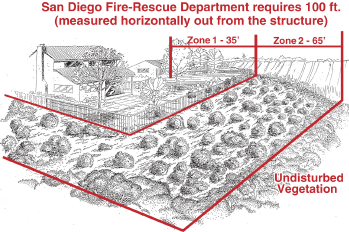Using brush management & weed abatement to create a sustainable defensible space for San Diego’s fire season
San Diego’s fire season typically begins in June, peaks in early fall, and ends after the first seasonal rains from December through April. The winter and spring rains fuel the growing season for native plants in Southern California. Brush management services are best performed after the spring rains have subsided (May – August) to insure that new growth has been removed (performing vegetation maintenance before or during the growing season will be in vain since new growth will form again before the fire season).
The City of Sa n Diego has created two specific brush zones for private property. These two zones total 100’ around structures. The first 35’ (Zone 1) should be an irrigated area with low growing plant material (less than 4’) on a level area surrounding structure (usually a backyard or landscaped area). Zone 2 is the remaining 65 feet that extends beyond Zone 1 and is usually comprised of native and/or naturalized vegetation. Zone 2 can have no permanent irrigation and must be thinned and pruned on a seasonal basis. Zone 2 is the area of brush management services.
n Diego has created two specific brush zones for private property. These two zones total 100’ around structures. The first 35’ (Zone 1) should be an irrigated area with low growing plant material (less than 4’) on a level area surrounding structure (usually a backyard or landscaped area). Zone 2 is the remaining 65 feet that extends beyond Zone 1 and is usually comprised of native and/or naturalized vegetation. Zone 2 can have no permanent irrigation and must be thinned and pruned on a seasonal basis. Zone 2 is the area of brush management services.
 In Zone 2, it is important to remove dysfunctional plant materials first and encourage less flammable native species. 50% of brush should be cut down to 6” high. Species removal should always be in the following order. 1) invasive non-native species, 2) non-native species, 3) flammable native species, 4) native species, and 5) regionally sensitive species. (Don’t’ clear cut areas because this will create an open area for fast growing highly flammable invasive species to become established).
In Zone 2, it is important to remove dysfunctional plant materials first and encourage less flammable native species. 50% of brush should be cut down to 6” high. Species removal should always be in the following order. 1) invasive non-native species, 2) non-native species, 3) flammable native species, 4) native species, and 5) regionally sensitive species. (Don’t’ clear cut areas because this will create an open area for fast growing highly flammable invasive species to become established).
 In Zone 2, large shrub and trees should be crown raised to reduce branches (fuel) close to the ground. These large species should be trimmed into the shape of an umbrella. Reducing low growing fuels while maintaining the crown of large shrubs and trees will reduce fuel as well as shade the area below the shrub to prevent invasive weed growth in this area.
In Zone 2, large shrub and trees should be crown raised to reduce branches (fuel) close to the ground. These large species should be trimmed into the shape of an umbrella. Reducing low growing fuels while maintaining the crown of large shrubs and trees will reduce fuel as well as shade the area below the shrub to prevent invasive weed growth in this area.
Creating a defensible space around properties has become increasingly important in San Diego. Let’s face it, do to population growth our homes and offices have been pushed further and further into naturalized areas where wild fires are a common and natural event. Creating a sustainable low fuel area is critical during periods of “firestorms” when firemen need every edge they have to protect our homes.
Current fire conditions can be monitored at The US Forest Service website. Learn more about invasive weeds at The California Native Plant Society.
Note: in some areas (coastal sage scrub, maritime succulent scrub, and coastal sage-chaparral habitat), brush management is restricted due to the Gnatcatcher nesting season (March 1 – August 15th). Permits can be obtained from the City of San Diego to have brush services performed during the nesting season if necessary; otherwise, brush services should be performed after the nesting season in these areas.
Would you like an Arborist to evaluate your property? Complete our Request Services form or contact us!

